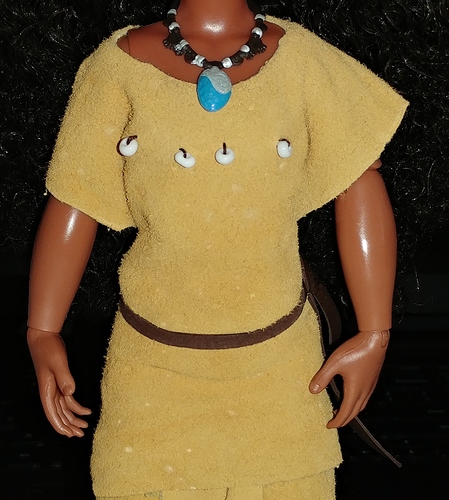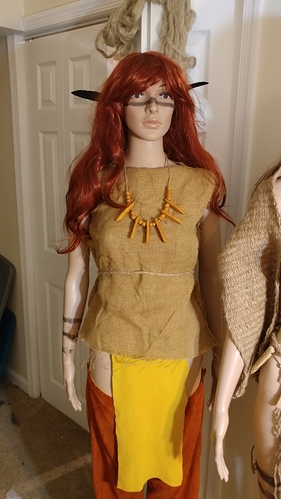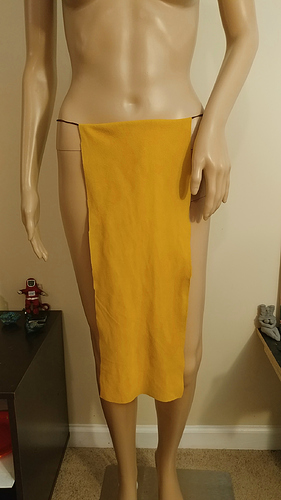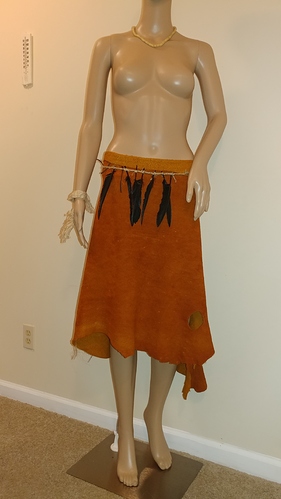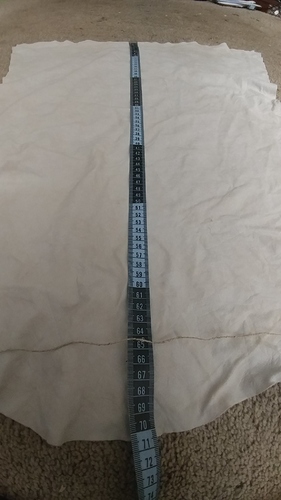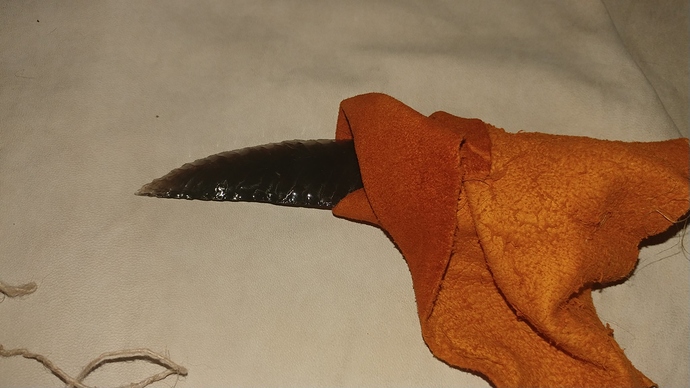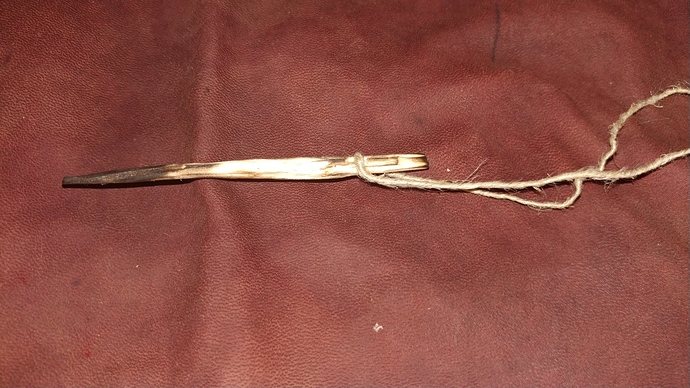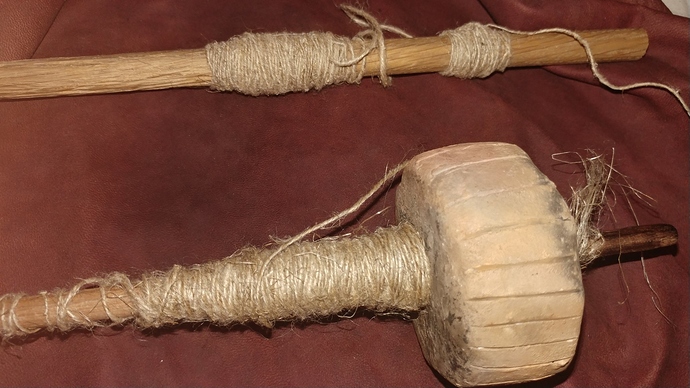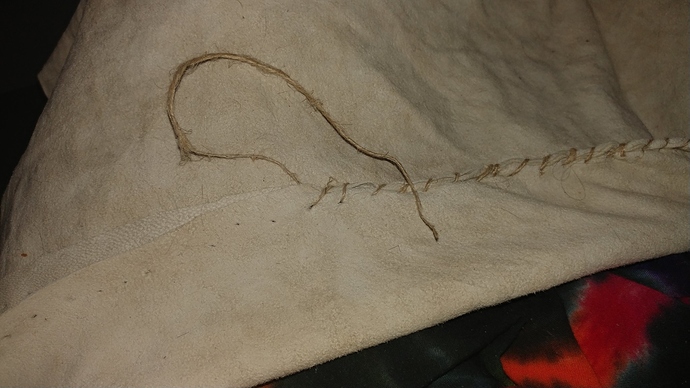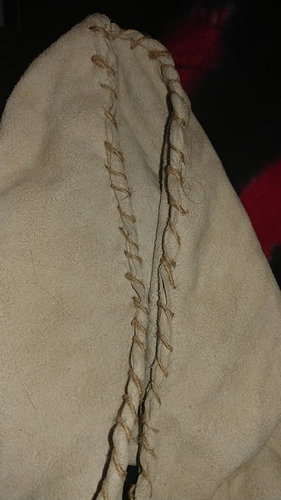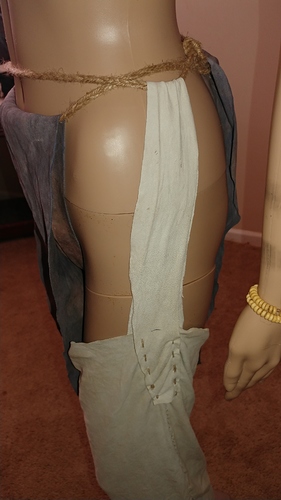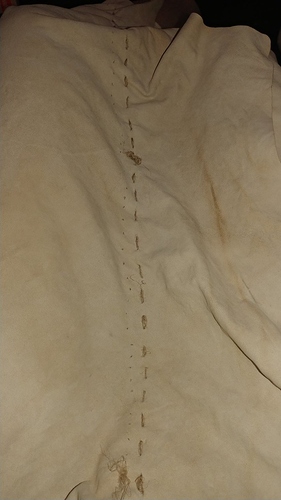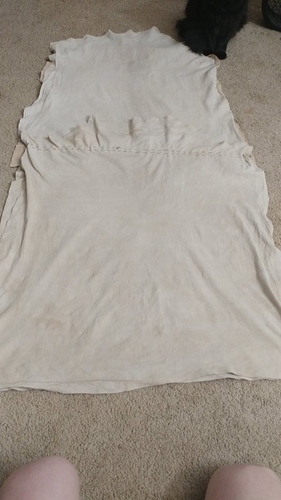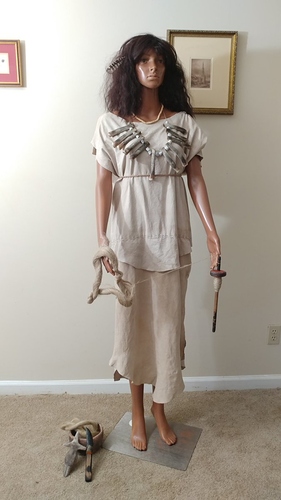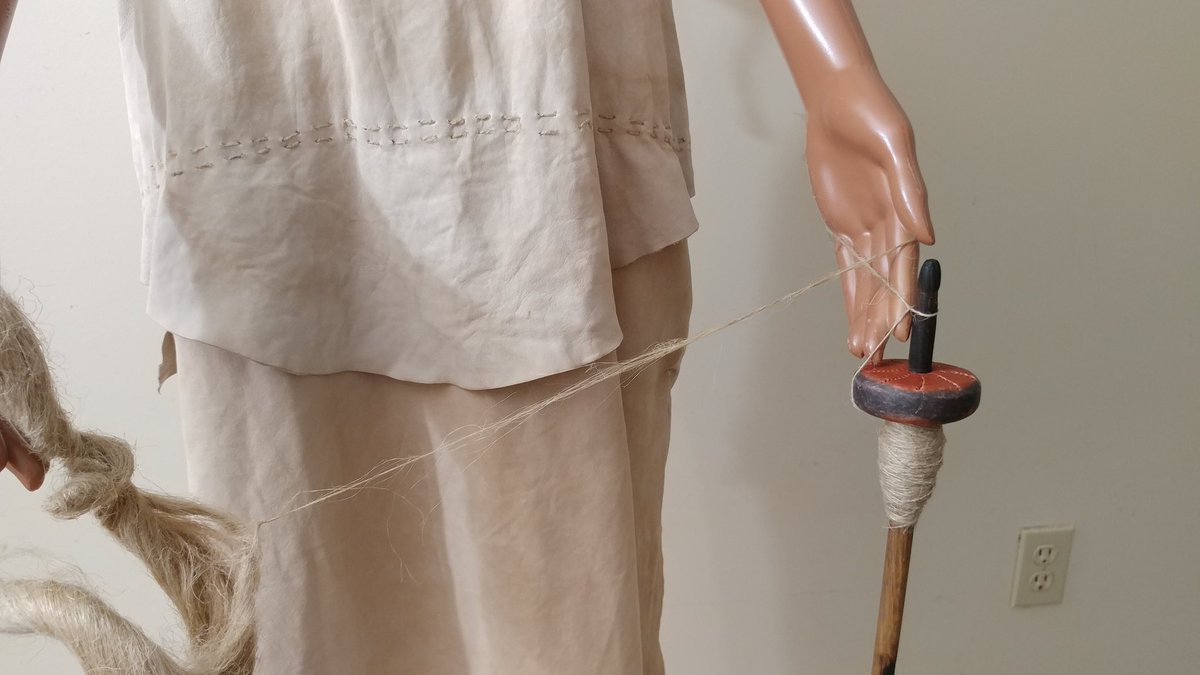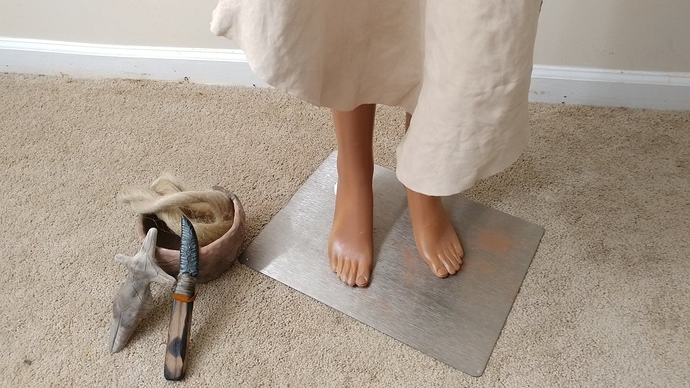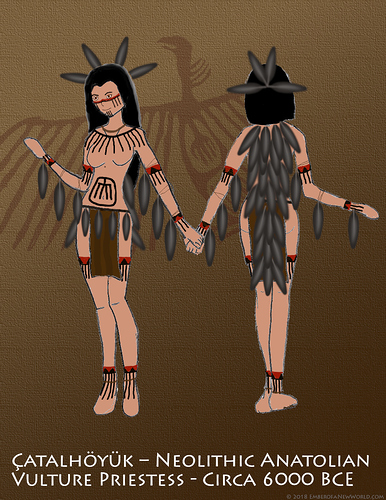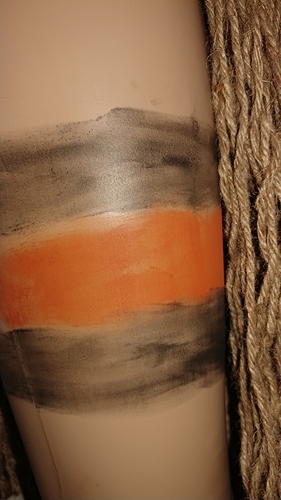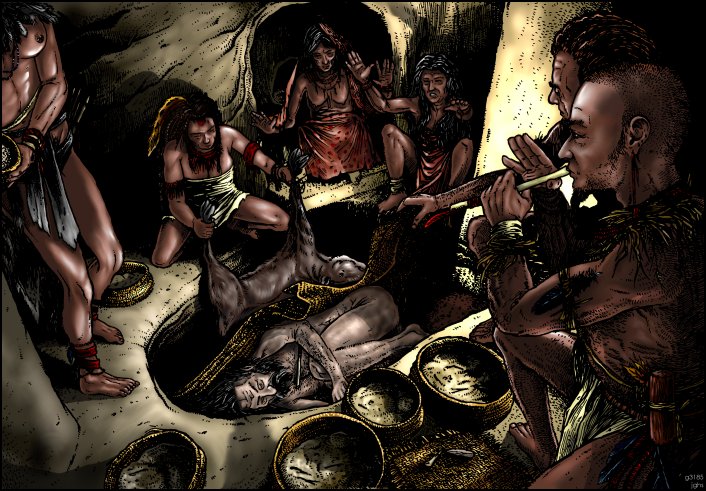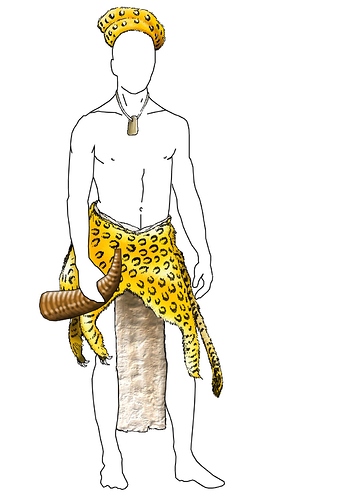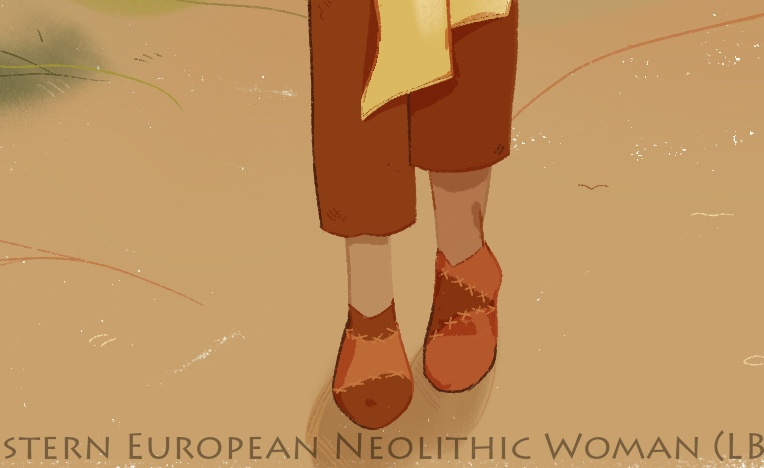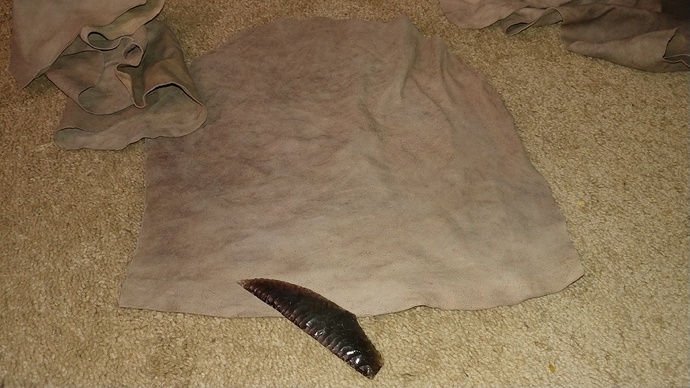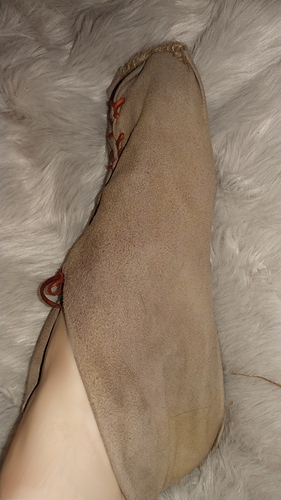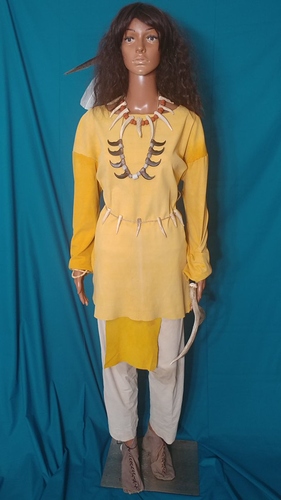Amazing,
I was just going to ask for some shoes examples 
I’ve only made two, and one of them was such a fail that I won’t post it LOL What I will do is post a number of good examples of what footwear should look like in the Neolithic, and perhaps some of the archaeologists in the Forum can double-check that they agree.
However it is important to remember that barefoot is the most likely state for Neolithic people in the summer, early fall, and late spring.
Neolithic Footwear
Neolithic footwear is a relatively misunderstood component of prehistory, like so many other subjects. The need to cover one’s feet is expressly important in cold climates, as well as desert climates with their Rocky Terrain.
Daily life
For most Neolithic people, whenever possible, barefoot was probably the likely form of “footwear.” Even in northern Europe, at least half of the year is relatively agreeable for bare feet, and footwear is both difficult to make and easy to wear out. Given its importance during the cold season, it seems unlikely a Neolithic person would waste of valuable commodity, which quickly degrades with use, during a warm season.
Neolithic woman working barefoot (note, this is what Neolithic people looked like, not those silly linen tunics lol)
When shoes were required, they could be made out of many different materials (described below) and probably took on many different forms, likely styles following the tribe in a cultural or regional fashion. This means that a group of tribes in one area might make their shoes a particular way, but a few hundred miles south they might make their shoes a different way using the same materials.
I should also point out that even in the coldest of winter, shoes were probably removed, as well as most clothing, when entering a fire warmed hut or longhouse. You will find this practice performed by many tribal groups in colder areas.
Huts with a hearth are very cozy inside.
Important note for the Developers
Every so often, shoes should require the character to spend a short time repairing. As often as once per day. The same repair work should be required for clothing and tools, at differing rates. Maintaining Neolithic tools and clothing was a Non-Stop, never ending process. this is extremely important for accuracy.
We will likely never know what exact styles were used, only what options they had available. We can infer their clothing to a limited degree from their artwork, but shoes are almost never depicted.
Some of the common materials that we’re likely used to make shoes, as well as some examples of such Footwear. Keep in mind that some of these examples are reconstructions, and they may not match your preconceptions:
Leather
Abundant, durable and easy to work with, leather is an obvious choice. Many types of tanning processes existed, including simple tanning using tree bark. Using such methods, large quantities of leather could be easily produced as the byproduct of the animals being brought in from hunting each day. Also, domestic animals could be used for leather, though this would be more limited as many domestic animals have a more useful function producing renewable resources.
Leather may inclued, but it’s not limited to, Pig, deer, cow, aurochs, marmot, elk, and many other small animals.
Leather shoes are usually either wrapped around the feet in their simplest form, or cut to shape and sewn using an awl to puncture holes, a bone needle to thread, and either bast fiber or sinew as the thread.
Leather shoes
Fur
Almost identical to leather but simply retaining the outer fur, virtually everything I said above concerning leather applies to fur. Fur has the benefit of retaining heat, but it also has several detriments involving water. If fur gets wet, it’s harder to dry than leather by itself. Fur can be aesthetic and also beneficial in the winter.
Fur hide shoes
Tree Bark
Tree bark clothing was quite popular in the Neolithic. Tree bark is stripped from the tree and the fibers are either peeled by hand or smashed and then peeled by hand. Certain types of trees are better for removal of tree Park fiber than others. Willow and lime are excellent choices. Once peeled, the fiber can be braided or simply bunched, using something like flax string to weave the pieces together. If properly processed, tree bark fiber is actually quite soft, producing a durable shoe that breathes.
Tree Bark shoes
Bast Fiber
Fibers made from Plants, such as flax, hemp or nettle can be spun or simply bunched in the same manner tree bark is bunched to produce woven shoes. If properly treated, bast fiber shoes are very soft and comfortable until the temperature becomes very low. These are the kind of shoes you would expect someone to wear around the tribe before the snows fall, only discarding when it became warm enough.
Best fiber can also be made into a sandal. In arid climates that are very warm, such as Anatolia and the Levant, a person might simply wear a loincloth, but they would still cover their feet with sandals against the rough, rocky ground. This is where bast fiber sandals and shoes become very important.
fiber sandals
Cold weather shoes
One might imagine that cold weather would simply require big burly leather and fur boots. The reality is that Neolithic people made all sorts of composite shoes from grasses intermixed in a framework of bast fibers with a shell of leather and fur around the outside. This is best illustrated by the shoes recovered from Otzi the Iceman, though it’s important to remember he is technically not Neolithic.
Variations in this form of Footwear were probably common throughout the Neolithic but have not survived. One of the key reasons behind the grass and netted interior is water. The sweat from the human foot and the water from outside of the shoe both have a very negative effect on the foot when it is cold. In effect, the actual protection afforded by the shoe is less important than its ability to remain dry. A high-quality pair of cold winter boots with their grass and fiber interior, with a leather exterior and potentially additional furs wrapped around them, would be considered a very prized item requiring continuous effort to maintain.
Otzi the Iceman’s shoes (reconstruction)
Over the next week or so, I’m going to pick one clothing article every couple of days and post an entire list of examples. Hopefully that will help. It looks like the day I started with Footwear LOL
Neolithic Clothing: Upper Garments
Neolithic people covered their upper bodies for many reasons, as we do now. The weather, decoration or necessity. We have little knowledge of what upper garments they wore, but we know a few things which can help us make a few educated guesses. We know what tools and materials they had, as well as their climate and needs. Further, we can glean a little from their artwork and the analysis of subsequent time periods with greater numbers of surviving garments.
It should be noted that, during the warm seasons, it was likely commonplace for both men and women to go without upper garments (aside from perhaps body paints and jewelry). Nudity was likely not a major issue.
https://www.pinterest.com/pin/378865387399532801/
Vinca figurine shows a loincloth or skirt, but no upper garment
Styles
Outfits may have been decorated with beads, paint, bones and many other items. Personalization is very important to humans and found throughout all cultures and people. It is important to keep in mind that design and artwork would have potentially varied quite a lot between cultures and people.
(This isn’t Neolithic, but the same styles would likely have been used)
Common materials used to add style to clothing:
(note the little bone beads)
Bone
Shell
Paint (orchre, madder, plants, ash, clay)
Feathers
stone (beads)
Clay (objects)
Rare Materials:
copper
gold
silver ← None of this has been found, but it very easy to use (cold forged). Time and greed
gems would liley have erased evidence. This remains, however, highly speculative.
Materials
Clothing would be maintained for long periods of time, being patched and reinforced constantly. As a result, even a small scraps would be sewn togeather to make clothing. Due to the prevelance of leather and animal products, these would have been the most common materials used.
Common materials for clothing would have been:
Leather - Durable, plentiful
Fur - Warm
felt - very warm!!! Middle to late Neolthic.
fish leather - thin, soft leather for clothing
(Example of fish leather)
reed - Capes, woven hats
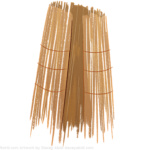
grass (bound with string/sinew)
Rare:
Textile - Uncommon until the end of the period. Ritual or status may have afforded some outfits. Smaller garments, such as shawls, may have been used.
(Mocked up linen shirt)
bead/shell - Not really covering and very delicate, such items would have been worn for ritual, status or in death.
https://www.pinterest.com/pin/378865387399532835/
(Woman wearing beads. This is for burial, though they may have also been used in ritual. She is late mesolithic, so very close to Neolithic)
Lower Garments
Neolithic people covered their lower bodies in various ways. Even when an upper body garment was optional, a lower body garment was likely not. Below are some of the
types of items Neolithic folk would wear.
https://www.pinterest.com/pin/70439181657605389/
(Neolithic People in the colder season)

[Uncredited. Cannot find the credits ![]() ]
]
(Neolithic People in the warmer season)
.
.
.
.
Note: When you see pictures showing Neolithic people wearing full length linen tunics, remember that we have zero evidence for this. Here are examples of what people wore in bronze age Minoa during the neopalatial period. This is MUCH later than the Neolithic, but we only see a skirt and a loincloth. As you can see, the silly tunics come out of our modern ideals and modesty being superimposed upon the Neolithic.
(Minoans)
.
.
.
.
Loincloth
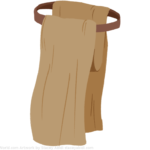
http://mini-girlz.tumblr.com/post/76789333954/on-this-statuette-found-in-austria-we-can-see-the
(Loincloths can be seen on many Neoithic figurines)
The Loincloth is the second oldest garment known to humanity (the simple bare waist cord being the first). It has been used by every single people on Earth at one time or another, and is still in use today. Given a lack of formal pants, loin cloths were worn with nearly all garments. They are historically worn by both men and women.
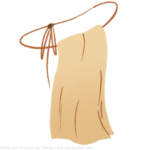
.
.
.
.
Skirt
Skirts provide excellent protection of the lower body and trap heat for cooler months. The skirt can range from easy to make (leather wrap) to complex (string skirt or textile). Likely, both men and women wore variations of skirts.
(Linen skirt)
(String Skirt)
(leather skirt)
(Woman wearing leather)
.
.
.
.
Leggings
(Loincloth and leggings)
Protecting the legs was important. Without pants, leggings filled the main role (along with long skirts). Leggings are tubes of cloth or leather, either tied around the leg or (more likely) connected to a belt at the waist. Note: Legging and loincloth were likely on separate cords to prevent the weight of both pulling them down.

(Leather leggings)
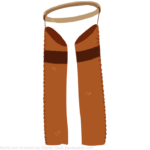
(Leather leggings)
.
.
.
.
Nude
[No, I didn’t include a photo lol]
When working in the water or in many laborious projects, going fully nude was likely common. In most contemporary examples, we find that women rarely do this, being more common among men. In most societies which do allow nudity, it is still important to follow customs, such as when, where and why one may go nude.
Neolithic Leggings
I set out to make a second pair of Neolithic leather leggings even better quality than my first. There are not many examples of Neolithic garments, but we can use Otzi the Iceman as a template. He is technically early copper age and not Neolithic, but he’s right on the edge of the Neolithic and he provides a very good data point for predicting Neolithic clothing.
if you’re interested in seeing more about Otzi the Iceman’s clothing, link below is for you!
Among his clothing, Otzi the Iceman wore a loincloth and leather leggings, and so I carefully examined his clothing for ideas. his leggings were approximately 65 cm in length, and there with was that of a man’s leg. This is approximately the size of a sheep skin without cut, which works out nicely. Of course, I tend to make women’s clothes so there are a few trimmings that had to happen as women have thinner and shorter legs.
As you can see, my leggings came out to about 65 cm, just as the ice man’s. Technically, the center dips down to about 70 cm, but that part isn’t actually sewn together making it sort of irrelevant to the overall length.
I was able to easily slice the right sized pieces using a sharp obsidian blade. This blade will be used in a dagger later, so I just wrapped it in leather for use today. I have several obsidian dagger’s sitting around for just such occasions lol
With the pieces both cut and fitted to the legs of the mannequin, it was now time to sew them together. Sowing in the Neolithic required puncturing holes in leather using a tool called and awl. I made an awl using a piece of bone which I carefully ground with stone until it was sharp. I punctured dozens of holes throughout the letter in the pattern I would then sew.
Sewing in the Neolithic simply required pushing a string through a premade whole, or through a not so densely woven fabric. I used to have a nice bone needle, but it has broken. I ended up using a wooden needle I quickly fashioned. Notice that it uses a hook and not and hole for the string.
I handed spun the string from flax. Nothing store-bought was used. Spinning flax is something I’m getting rather good at now. I use the spun flax on my loom, or when making clothing, such as this.
Once the leather was fully sewn, I’ve flipped it inside out causing the stitching to be in the inside of the leggings. This looks much better than being on the outside. The flax did a really good job on the leather!
As you can see, the leggings keep the legs warm and attached to a waist cord. A breech cloth or loincloth hangs between them. In this way, the first pant like clothing was made. Remember, all the way until the 1500s, pants were quite difficult to make an often made similarly to this with a codpiece in the front. You might also recognize the design as it looks similar to Native American leggings. Everyone had the same basic idea and the same basic tools and materials, so parallel development definitely occurred. Though you can see that there are differences between Otzi’s design and Native American designs.
Lifting the loincloth, it’s easy to see how it functions going between the legs and providing ample warmth and protection. Ozti’s loincloth was about 2 inches wider and about half as long as this one. A longer loincloth provides better protection and better warmth for the wearer. His was made by many strips of goat and sheep leather sewn together, while this one is made of two panels of goat leather sewn together.
lastly, a rather elegant strap is soon at the side allowing the leggings to be connected to a waist cord. As you will learn if you ever wear such an ensemble, you always use a separate waist cord for leggings and loincloth. This can be seen in modern garters that hold up women’s nylon leggings. They are separate from the strings on the side of panties for the same purpose, as they also serve the same function in women’s underwear.
This week, I am working on a leather shirt. I will post the information when it’s done.
Just out of curiosity: I’m lacking the appropriate vocabulary in English, but you say you turned the “bulge” due to the sew inside-out.
Don’t you fear this make the legging uncomfortable? Looking at my jeans, that’s obviously the way they’re done, but this was hand-made, so maybe more scratchy?
My spun flax string is pretty soft. It’s pulled tight against the leather and uses long, soft flax. I have worn the leggings and they are quite comfortable. If you used modern jute or hemp cord, it would certainly be uncomfortable. Using beaten flax or sinew is comfortable \o/
(Also, your English sounds perfectly fine to me lol)
If all of you are curious as to why I keep posting information about Neolithic clothing, including the clothing that I make, it’s because the people making the game will eventually need to make proper Neolithic clothing samples.
When this happens, they will need far better examples than what you usually find on the internet. Most of the examples I see in the internet are completely incorrect and without any basis. I don’t want to run the risk that they end up making incorrect clothing.
Did you already though to study in archaeology? It’s a real discipline called experimental archaeology what you are doing  very nice !
very nice !
My background is computer science, and that’s what I’m going to be pursuing my graduate degree in. For me, this is more of a hobby. I wouldn’t mind getting a few courses in the subject to help me, however.
@MarcTheGoldenFox is right! In fact, I don’t even think you’d need courses, just to cite your sources and write down what you do in an organized way. As Adam Savage from Mythbusters said: “the only difference between screwing around and science is writing it down”, and you’re screwing around with great method and precision 
Neolithic Leather Dress
In case you are wondering, this is likely the sort of thing a woman would wear in fall or spring. It has side slits to make work easier. It’s high enough that she can hold something without needing to hold her dress while walking up a rocky slope or stepping. The width allows for her to be pregnant or not without alteration.
I spent many hours working on spinning the flax string to be used in the dress.
About 30 hours were spent poking holes in the leather with a bone awl and stitching the holes together using a wooden needle.
Each panel was made from two skins. These are from sheep, but they are nearly identical to goats, a common leather source for Neolithic people (Otzi the Iceman’s loincloth and leggings were made from goat skin).
DONE! See how she wears a flax cord around her upper torso to provide some support? That makes walking around more comfy \o/
She holds a spindle in one hand and flax in the other (it should be spread out, but it’s hard to make a mannequin hold that lol).
She wears a beautiful rib bone necklace and bone bead necklace to accentuate the look.
At her feet, a pot with flax, a goddess figurine and an obsidian knife stand at the ready!
5500BCE Early Western European Neolithic Woman
LBK Culture. Circa 5500 BCE
Left to Right:
-
Red deer loincloth fastened with a braided flax cord belt protects the groin. Longer and broader loincloths provide extra warmth in the cold.
-
Goat Skin leggings fastened with a braided flax cord belt keep the legs warm from drafts. Roe deer leather boots protect the feet*
-
Goat and sheepskin leather dress warms the body
-
Tools are attached to the waist with a braided flax cord belt. Tools pictured: Sheath holding an obsidian dagger, spindle with clay whorl, flax to spin, a goddess figurine, woven flax and wool cloth. A bear claw necklace provides fashion or status
-
Bear fur cape warms the body while rabbit fur mittens and cap warm the hands and head. Pheasant feathers attach to the hair with clay beads providing fashion
- Boots are not yet done, so I am using felt placeholder “boots” until then.
Note: This was done in the style commonly used to show off dressing of historical characters, such as Otzi the Iceman
Çatalhöyük – Neolithic Anatolian Vulture Priestess - Circa 6000 BCE
<<< Garment is under construction. Pictures posted when complete >>>
I am making an authentic vulture priestess outfit. Here is the design and the rational behind it. Keep in mind that such people should exist within the game. I don’t expect this level of detail, but animal costumes are important for animism.
(Yes, I drew this… Yes, I know it has issues lol)
Arms: 10 feathers
Back: 64 Feathers, 4 rows of 16. Tail made from 10 feathers
Head: 4 feathers
Waist: 8 feathers, waist cord, loincloth
Black Pigment: Wood Ash
Red Pigment: Red ocher
Cordage: Hand spun flax (by me!)
Loincloth: Oiled goat leather
[I am writing up a full paper for this project, but this is the first light draft. It’s plenty detailed for a forum post, however]
Introduction
Between approximately 7500 BCE and 5500 BCE, the proto-city of Catalhöyük (pronounced “cha-tall-ho-yook”) flourished in what is now south central Turkey, on the Konya plain. At its height, it may have had a population of as many as 10,000 people. To date, very little evidence exists to suggest any major centralized form of government or any particular difference between the way men and women were treated, a relatively peaceful existence for perhaps two thousand years.
The proto-city was composed of hundreds of multi-story mud-brick cubic houses, entered through their roofs via ladders. Waterways running between the two elevated land areas forming the city supplied fish, mollusks, reeds and water, while extensive farming provided flax and wheat for the large, growing population. To date, Catalhöyük is one of the best preserved Neolithic sites in the world offering visitors a look at an ancient proto-city from our past.
Among the better preserved artifacts of Catalhöyük are a series of painted murals and ceramic figurines providing a limited but interesting view into the life of these ancient people. Many animals, what appear to be religious symbology, and even depictions of hunting can be found in these artifacts. Three animals which stand out as being both prominently displayed and potentially religious in nature are the bull, the leopard and the vulture. These animals are depicted on many artifacts providing a wealth of information for the amateur reconstructive archaeologist. It was using these items as reference points for both inferential and comparative analysis that a reasonable depiction of a vulture priestess could be compiled.
Why a Priestess?
Male figurines are uncommon at Catalhöyük. It may be that their culture simply did not favor the depiction of males, the method used to depict males did not lend itself well to preservation (e.g. wooden figurines), or perhaps only women presided as religious figures (as seen in many animistic cultures).
Which Vulture?
Whichever vulture was revered by the people of Catalhöyük should both have been common and reasonably similar to the depictions of vultures in the artwork found. The Cinereous vulture and the Egyptian vulture are both common to the area. The depictions of the vultures are reasonably iconographic having aspects common to many large birds, but the characteristic vulture like beak and the large wingspan clearly depicted vulture. Unlike the Cinereous vulture, the Egyptian vulture has a pronounced plume of feathers emanating from its head in such a way that it reasonably matches the depictions in Catalhöyük.
https://www.pinterest.com/pin/495677502722573677/
Feather Color
The Egyptian vulture has several color variations, but the largest feathers are reasonably black. While any size feather may have been used, it is reasonable to suppose the largest feathers would have been used to provide the closest scale when worn by a human. The largest feathers on Egyptian vulture are black with occasional earthen tones. The lighter colored skin of the priestess or dancer directly contrasting the dark feathers is a reasonable facsimile to the actual coloration of adult Egyptian vultures. Adolescent Egyptian vultures would be nearly completely black. In the case that the priestess or dancer were an adolescent, one might suppose that their entire body would be painted black to match the adolescent bird. There is no way to know if such a priestess or dancer would have been adolescent or adult, but a comparative look at recorded cultures both past and present who practice animism shows us that adults are typically the holders of clerical positions, thus we can reasonably suppose an adult practitioner with black flight feathers and the lighter brown skin of a Catalhöyük inhabitant.
https://www.pinterest.com/pin/453034043747207767/
Body Paint
Red colorant from ocher and black pigment from burned ash have been found on many murals at Catalhöyük, often in a sort of triangle or chevron pattern, their colors contrasting. Given striking nature of these colors as well as the reference to both blood, red, and black winged form of the vulture, black, as well as the prominence of such designs throughout Catalhöyük, it seems reasonable to use these colors as a sort of accent coloring. Stripes across the body are commonplace throughout depictions of people in the Neolithic, and may simply have been born as a method of dehumanizing otherwise naked skin for the purposes of animism. The reduction of anthropomorphism is important when one is attempting to convey a physical role as the invocation or at least representation of an animal.
The usage of line art in the form of roughly vertical black lines emanating from various parts of the body is a direct reference to the depiction of feathers displayed on the murals depicting vultures. The usage of these lines on the extremities is corollary to the analogy of the arms and legs as representative of the vultures wings and talents, respectively. The central circular pattern on the abdomen is again representative of the common depiction of the vulture in Catalhöyük.
Feather Placement
the placement of the feathers along the arms is a direct analogy to wings. The rationale for having only a few feathers derives from the nature of how the feathers are accessed. If the vulture carried the religious significance its depictions suggest, then the active either killing such a bird to obtain a large number feathers or desecrating the body of such a fallen animal may have been considered abhorrent. Whereas, a feather fallen of its own accord could be seen as a gift. The amount of time required to gather all of the feathers needed to make a single outfit may have been several years. As a result, a very conservative usage of feathers seems pragmatic.
The reason for the feather cape and tail feather apparatus is a direct appropriation of the animistic concept of wearing the skin of the animal you wish to become. Artwork at Catalhöyük clearly depicts hunters carrying and even wearing the skins of leopards, possibly to gain the abilities of the leopards. While it could be argued that the pictures depict men wearing the hides as loin cloths or tearing them in their hands, versus donning the outfits over their bodies, one must also consider the context in which they are depicted. The leopard skin people appear to be hunting people, something rather cumbersome while wearing a skin in the warm summers of the Konya plain. While it is certainly possible feathers might simply have been held in the hands and not worn as a costume, it seems reasonable that a priestess would have found a greater perceived connection when donning an entire outfit, rather than simply holding a feather. Animism typically involves the practitioner believing either that they are communing with or perhaps becoming the creature more spirit they invoke.
Clothing
Commonplace clothing is often not depicted in primitive artwork, rather being assumed. While this might lead figurine in the mural or the ceramic figurine to appear nude, this may not always be true. In the case of religious symbols, to include deities and spirits, the figure does appear to be commonly nude, clothes perhaps not being important to a divinity. However, in the case of figures who appear to be representative of real people, waist cord and occasionally more complex clothing designs can be seen. While it is therefore impossible to know whether or not a vulture priestess would have worn clothing beyond her decorations or not, it is probably reasonable to presume at least a simple loincloth was born. Vulture worship was probably not linked with fertility, but rather death and the beyond. During the cold season, such rituals were probably held within buildings where it was warm, and during the warm seasons they might’ve been held outside were on top of buildings. Either way, a simple loincloth was added as a reasonable guess.
I do find it interesting that Stanford University, a leading University in the research and excavation of Catal Hoyuk, have illustrations of daily life in that settlement which more closely match the way I depict it than the way it is usually depicted for the General Public. It would seem that the archaeologists have come to similar conclusions and that the portrayal for the general public has been poorly portrayed.
“G3182.jpg,” Stanford Figurines Project , accessed September 13, 2018, https://web.stanford.edu/group/figurines/cgi-bin/omeka/items/show/6831.
I have contacted the University to see if I can use some of their illustrations in my own project, other than simply referring to them. Since I donate to their archaeological work, I’m hoping they’ll be nice and get back to me lol
“E2815.jpg,” Stanford Figurines Project , accessed September 13, 2018, https://web.stanford.edu/group/figurines/cgi-bin/omeka/items/show/6871.
“E1142.jpg,” Stanford Figurines Project , accessed September 13, 2018, E1142.jpg · Stanford Figurines Project.
What I am going to try to do is find out why the people at the Catal Hoyuk project continuously depict the inhabitants as having mohawks or shaved bald.
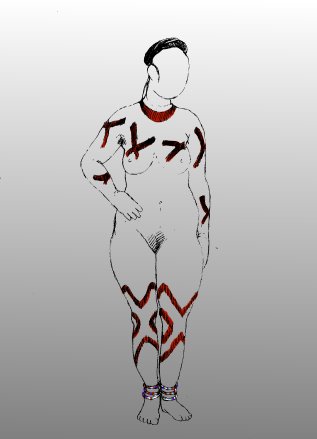
“E945.jpg,” Stanford Figurines Project , accessed September 13, 2018, https://web.stanford.edu/group/figurines/cgi-bin/omeka/items/show/6809.
I believe the red x pattern you see on their bodies is a large-scale variation of the chevron design I drew on the bands surrounding the arms and legs of my vulture Priestess design. I believe they came to the same conclusion as I did, but on a much larger scale LOL I actually think I might prefer theirs.
Lastly, I’m a bit confused at their illustrations where the figures wear clothing made of almost net like designs. While I agree that during the summer months you could easily wear such a thing and be quite comfy as it protects nothing nor hides anything, but during the winter you certainly couldn’t wear such a revealing outfit or you would freeze to death. I’m curious where they got that idea as it’s more risque than even one of my own designs.
Neolithic Leather Shoes
I based my shoes on the 3500 BCE areni-1 shoe from Armenia. They were found in a cave nearly intact! Similar shaped shoes have been recovered around the world and the style is used to this day in some places. Step one: cut out the shapes from leather using an obsidian blade. I used sheep leather which is probably too light, but was fine for demonstration. A thicker leather would be better for longer-term use.
Holes are punched in the leather with a bone awl. The toe is sewn with flax while the center part of the shoe is laced with leather thong. The leather thong can be made with a sharp obsidian blade cutting a narrow strip from leather.
As you can see, they are comfy and rather stylish, even on my ugly feet lol
Not counting the time of tanning, each shoe takes about 4 hours to make, so it would be rather easy for a tribe to make a lot of these. However, it is most likely that people were bearfoot most of the time (until it got cold of course) to conserve their shoes, regardless.
I know it’s not 100% proper for this thread, but I could not help…
Here is my Halloween costume for this year (I’m in the USA where we celebrate Halloween). The costume is 100% handmade by me using only Neolithic tools and techniques. It’s an early Western European Neolithic outfit (Linear Pottery Culture).
Not only is it my costume, but it is also fall/spring clothing for the people in this very game (their semi-cold clothing should look like this).
Note the deer antler belt and necklace. 
This entire outfit took me something like 40-60 hours to make, not counting tanning. =/
If it had been linen, you could have easily multiplied that by 10.


